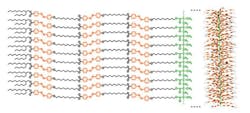Aramaki, Japan--Riken, a natural-sciences research institute, has created a macroscale polymer film material that mechanically moves when light is shed on it. (Microscale motion via light can be accomplished in other ways--for example, in a light-driven molecular brake.)
The material is a kind of "polymer brush," which has a structure in which a main chain densely branches into long side chains (see figure). The material was made into a film by embedding azobenzene molecules (whose structure is changed by light) in its side chains and applying heat and pressure.
When UV light with a 360 nm wavelength was applied, the film bowed; when visible light with a 480 nm wavelength was applied, the film returned to its original shape.
Specifics
After polymer "brushes" having azobenzene molecules in their side chains were heated to 130°C, they were left at a temperature of 115°C for about an hour. Next, they were cooled down to room temperature to be made into a 10-micron-thick film measuring 5 x 6 mm in size.
In the process of hot pressing, the film was sandwiched between polytetrafluoroethylene (PTFE) sheets, which improve the degree of detachment, so that the orientations of the polymer brushes are all aligned.
Riken examined the structural details of the polymer material using its "Spring-8" large-scale-radiation light facilities. Scientists at the institute discovered that the polymer brushes detect the molecular orientation of the one-dimensional carbon backbones located on the surfaces of the PTFE sheets; the polymer brushes then form two-dimensional rectangular lattices in accord with the information, forming a regular three-dimensional accumulation structure.
The polymer material is expected to be used in artificial muscles that move using light. In addition, it is possible to cause functional molecules to carry electrons from the front side of a film to the back side, enabling high-efficiency organic thin-film photovoltaic cells, according to Riken researchers.
source: Tech-On
Subscribe now to Laser Focus World magazine; it’s free!
About the Author
John Wallace
Senior Technical Editor (1998-2022)
John Wallace was with Laser Focus World for nearly 25 years, retiring in late June 2022. He obtained a bachelor's degree in mechanical engineering and physics at Rutgers University and a master's in optical engineering at the University of Rochester. Before becoming an editor, John worked as an engineer at RCA, Exxon, Eastman Kodak, and GCA Corporation.

